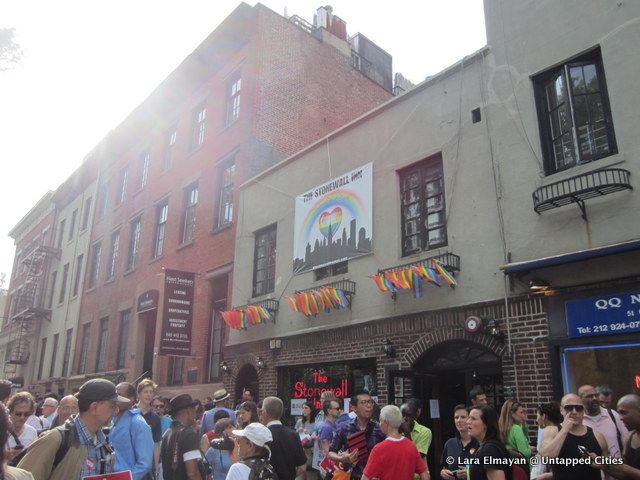Last-Minute NYC Holiday Gift Guide 🎁
We’ve created a holiday gift guide with presents for the intrepid New Yorker that should arrive just in time—



Last week Rick Landman – activist, attorney, and former executive director of real estate for the city – gathered about a dozen interested parties for his annual “LGBT History and Adult Use Zoning Tour” through the West Village. We began outside the Stonewall Inn – site of the uprising that jumpstarted the gay rights movement, and ended at the Hudson River – where now-long-gone piers were once bastions of anonymous sex.
A lifelong New Yorker, Landman has seen firsthand the evolution of a forty-something year-old movement – and the neighborhood that spawned it. Gay New Yorkers today take for granted the West Village as a gay utopia. Now there are gay bars in Harlem and Brooklyn, Grindr, and dozens of neighborhoods worldwide that consciously try to emulate the Village’s cool, artsy otherness. But as Landman points out, it was a very particular combination of zoning and economic malaise that in the 1970s laid the ground for New York’s – maybe the world’s – first gay neighborhood.
Until the 1970s, much of what we now call the West Village was zoned for manufacturing use, a legacy of lower Manhattan’s three-hundred-year-old history as a functioning port. Just as Soho’s spacious factory lofts were appropriated by artists around the same time, the abandoned warehouses on downtown’s west side became the preferred cruising ground for New York’s largely underground gay community.
The Stonewall Inn was opened by the Genovese crime family in 1967 and was the largest gay establishment in the US. Two years later, on June 28, NYPD descended on the bar in one of its frequent raids on gay bars. (Cross-dressing, which was illegal at the time, was the easiest and most common offense the police pursued). June 28 was different however; for the first time, patrons fought back, sparking what would become known as the LGBT liberation movement. On the first anniversary of the raid, the LGBT community staged a march from the bar to Central Park, a march that would be repeated every June since – the first gay pride parade. Some attribute the movement’s early traction to the presence of the offices of the Village Voice a few doors down from the bar, a coincidence that provided a relatively sympathetic mouthpiece for the cause.
In the following years, the area around Stonewall has become ground zero of gay culture in the city. In 1979, a prominent billboard at the intersection of Christopher Street and Seventh Avenue was adorned with the message “Gay Rights. Register & Vote,” referencing a gay rights bill that took 15 years to pass. The billboard, owned by the Lamar Advertising Company, still frequently features ads (some rather tongue-in-cheek) targeting the gay demographic, for vodka, dating apps, and charities. Today’s poster features a purportedly bisexual puppy who wants to be adopted.
In the rough-and-tumble days of the Koch mayoral administration (1978-1989), public drunkenness, drug use, and anonymous sex were rampant, and considered fairly staid next to the muggings and murders that earned New York its notoriety around that time. Where today stands a Brooklyn Industries outpost on the corner of Christopher and Hudson streets, was once a gay bookstore with a not-so-secret sex club downstairs. The city for years tried to close it down under the guise of a variety of fire codes and landmark violations. Giuliani’s no-nonsense approach to crime effectively sealed the fate of the West Village’s freewheeling gay culture.
And then there was AIDS. Some attribute Mayor Koch’s early avoidance of the epidemic to his own ambiguous sexuality. Nevertheless, New York City was with San Francisco among the earliest and most resolute administrations to address the outbreak. The Village’s St Vincent’s Catholic Medical Center was one of the first in the nation to offer HIV treatment, despite the church’s attitude toward homosexuality. (A staffer outside a Catholic church on Christopher Street, upon overhearing the topic of our tour, shouted “free testing!”). Bankrupt, St. Vincent’s closed in 2010. The New York City AIDS Memorial is set to open on a portion of the former hospital grounds late in 2014. The rest will be converted to condos.
Still a locus of New York’s gay community, the West Village of 2013 is nearly unrecognizable from the West Village of just 20 years ago. In the 1980s, a city rezoning allowed residential development in the warehouse district near the water’s edge. Like artists in Soho, the Village’s gays helped update historic buildings and opened shops and restaurants that attracted a wider, wealthier clientele. A neighborhood once embraced for its off-the-beaten-path grunginess and low profile is now among the most exclusive in the city. Citibank and Dunkin’ Donuts occupy street corners where they once wouldn’t be caught dead. Gays of lesser means have moved to Chelsea, Hell’s Kitchen, the outer boroughs. Mobile apps have made gay watering holes largely defunct. But one of the biggest reasons for the changes wrought on the Village is maybe cause for celebration: wider social acceptance means a minority population no longer finds it necessary to cluster together in an urban ghetto.
Subscribe to our newsletter